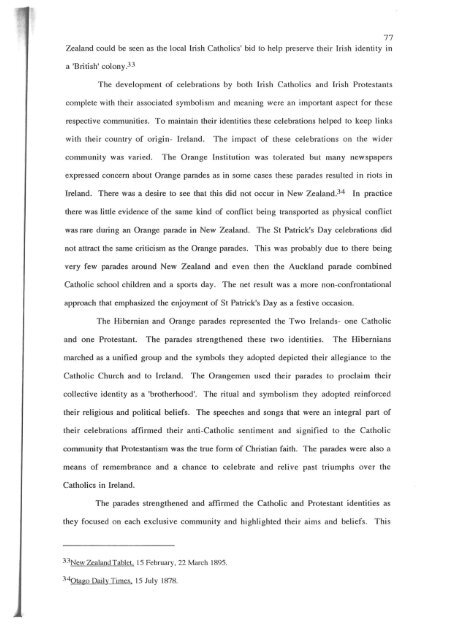TRANSPLANTED IRISH INSTITUTIONS - University of Canterbury
TRANSPLANTED IRISH INSTITUTIONS - University of Canterbury
TRANSPLANTED IRISH INSTITUTIONS - University of Canterbury
You also want an ePaper? Increase the reach of your titles
YUMPU automatically turns print PDFs into web optimized ePapers that Google loves.
77<br />
Zealand could be seen as the local Irish Catholics' bid to help preserve their Irish identity in<br />
a 'British' colony.33<br />
The development <strong>of</strong> celebrations by both Irish Catholics and Irish Protestants<br />
complete with their associated symbolism and meaning were an important aspect for these<br />
respective communities. To maintain their identities these celebrations helped to keep links<br />
with their country <strong>of</strong> origin- Ireland.<br />
The impact <strong>of</strong> these celebrations on the wider<br />
community was varied.<br />
The Orange Institution was tolerated but many newspapers<br />
expressed concern about Orange parades as in some cases these parades resulted in riots in<br />
Ireland. There was a desire to see that this did not occur in New Zealand.3 4<br />
In practice<br />
there was little evidence <strong>of</strong> the same kind <strong>of</strong> conflict being transported as physical conflict<br />
was rare during an Orange parade in New Zealand. The St Patrick's Day celebrations did<br />
not attract the same criticism as the Orange parades. This was probably due to there being<br />
very few parades around New Zealand and even then the Auckland parade combined<br />
Catholic school children and a sports day. The net result was a more non-confrontational<br />
approach that emphasized the enjoyment <strong>of</strong> St Patrick's Day as a festive occasion.<br />
The Hibernian and Orange parades represented the Two Irelands- one Catholic<br />
and one Protestant. The parades strengthened these two identities. The Hibernians<br />
marched as a unified group and the symbols they adopted depicted their allegiance to the<br />
Catholic Church and to Ireland. The Orangemen used their parades to proclaim their<br />
collective identity as a 'brotherhood'. The ritual and symbolism they adopted reinforced<br />
their religious and political beliefs. The speeches and songs that were an integral part <strong>of</strong><br />
their celebrations affirmed their anti-Catholic sentiment and signified to the Catholic<br />
community that Protestantism was the true form <strong>of</strong> Christian faith. The parades were also a<br />
means <strong>of</strong> remembrance and a chance to celebrate and relive past triumphs over the<br />
Catholics in Ireland.<br />
The parades strengthened and affirmed the Catholic and Protestant identities as<br />
they focused on each exclusive community and highlighted their aims and beliefs. This<br />
33New Zealand Tablet, 15 February, 22 March 1895.<br />
340tago Daily Times, 15 July 1878.
















